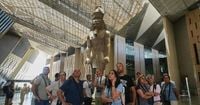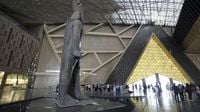On November 1, 2025, Egypt will unveil the Grand Egyptian Museum (GEM), a colossal new cultural landmark set against the awe-inspiring backdrop of the Giza Pyramids. After years of anticipation, delays, and painstaking preparation, the GEM’s grand opening marks a pivotal moment not only for Egyptian heritage but also for the nation’s economic ambitions and global standing. Officials and experts alike are betting that this vast, state-of-the-art institution will breathe new life into Egypt’s tourism sector, which has weathered more than a decade of turbulence.
Spanning an impressive 500,000 square meters—about 70 soccer fields—the GEM is the largest museum in the world dedicated to a single civilization. Its monumental glass and sandstone facade rises from the desert just outside Cairo, a literal and symbolic bridge between ancient wonders and modern innovation. According to Reuters, the museum overlooks the Giza Pyramids, placing it within arm’s reach of one of humanity’s most iconic sites. This proximity is no accident. As Prime Minister Mostafa Madbouly told Amwal Al Ghad, the museum’s location is a strategic advantage, ensuring that visitors drawn to the pyramids will be hard-pressed to skip the museum.
Inside, the GEM houses more than 100,000 artifacts spanning seven millennia of Egyptian history, from the Pharaonic era through Greek and Roman antiquity. Among its treasures, the complete collection of boy-king Tutankhamun’s artifacts—over 5,000 pieces, including the legendary golden funerary mask—will be displayed together for the first time. As if that weren’t enough, the museum also boasts the 42-meter-long funerary boat of Pharaoh Khufu, also known as the Cheops ship, which is over 4,000 years old. Visitors will enter through the Grand Hall and ascend a dramatic staircase flanked by colossal statues and towering hieroglyphic columns, leading to thematic galleries that weave royalty, society, and religion into a panoramic narrative.
The museum’s curatorial approach is a departure from tradition. As archaeologist Magdi Shakir explained to Daily Sabah, “In the past, artifacts from the Old, Middle or New Kingdoms were displayed separately. Now, each theme is presented in a panoramic narrative. Each object in the Grand Egyptian Museum follows a unique curatorial story, offering a fresh perspective even on familiar pieces—making it an unprecedented experience.” Rather than isolated displays, the GEM offers visitors a sweeping journey through Egypt’s power, daily life, and beliefs across dynasties.
The opening ceremony is set to be a spectacle in its own right. Egypt’s Minister of Tourism and Antiquities, Sherif Fathy, promised in The National that it would be “a night to remember.” The guest list reads like a who’s who of international politics and culture, with German President Frank-Walter Steinmeier among the dignitaries confirmed to attend. A torchlight procession will ceremoniously transport Tutankhamun’s treasures from the old Egyptian Museum in Cairo’s Tahrir Square to their new home at the GEM. For those unable to witness the event in person, the proceedings will be live-streamed on the Grand Egyptian Museum’s TikTok channel at 6 pm local time.
The museum’s ambitions extend well beyond dazzling exhibitions. Its conservation and research facilities are among the most advanced in the world, featuring 19 specialized laboratories connected by an underground tunnel. These labs are dedicated to safeguarding everything from fragile papyri to sculptural fragments and human remains. Egyptologist Mustafa Al-Waziri described the GEM to Nile FM as “an icon, celebrating Egypt’s rich heritage and reinforcing its status as a premier cultural and tourist destination.” The museum is poised to become a hub for both tourism and scientific research, drawing scholars and experts from around the globe.
Sustainability is another cornerstone of the GEM’s design. The building incorporates passive cooling, optimized lighting, extensive recycling, and a solar power plant. Its orientation and construction allow for natural wind cooling and significant reductions in energy and water consumption—up to 60% and 34% less, respectively, compared to similar buildings. These efforts earned the GEM the EDGE Advanced Green Building Certification in 2024, underscoring Egypt’s commitment to environmental stewardship even as it celebrates its ancient past.
The stakes for Egypt’s economy are high. Tourism revenue has long been a lifeline, providing crucial foreign currency for essential imports like fuel and wheat. After years of instability, the sector has shown signs of recovery: 15.7 million visitors brought in a record $15 billion last year, according to official figures. Yet Egypt still lags behind regional competitors like Turkey, which drew more than 50 million international visitors and over $60 billion in revenue last year. Officials believe the GEM could attract up to 7 million additional visitors annually, potentially boosting total tourist numbers to around 30 million by 2030.
To support these ambitions, Egypt has invested heavily in infrastructure. Roads leading to the museum have been upgraded, and a new airport has been constructed about 25 kilometers from the GEM to ease access. The entrance to the Giza Pyramids has been relocated to the back side, aiming to reduce crowding and protect visitors from aggressive touts. The hospitality sector is expanding as well, with 5,000 new hotel rooms added to the existing 235,000 and another 9,000 planned by the end of the year, according to Tourism Minister Sherif Fathy.
Yet the project has not been without controversy. The Financial Times reported that construction costs exceeded $1 billion, funded in part by Japanese loans, government resources, and revenue from traveling exhibitions. Critics have questioned the wisdom of such a massive outlay in a country grappling with social and economic challenges. Others worry that the GEM’s central role in Egypt’s tourism strategy could sideline other regions. Political oversight is also a point of contention: President Abdel Fattah el-Sisi chairs the board of trustees that governs the museum, with Minister Sherif Fathy as chairman.
Despite these debates, the sense of national pride is palpable. For many Egyptians, the GEM is more than a museum—it’s a statement of identity and resilience, a place where Egypt’s ancient glories and future aspirations converge. As the world tunes in for the grand opening, the hope is that the GEM will not only showcase the treasures of the past but also ignite a new era of cultural and economic vitality for Egypt.
With its doors about to open wide, the Grand Egyptian Museum stands ready to welcome the world—offering visitors an unparalleled journey through history, innovation, and the enduring spirit of a nation.


